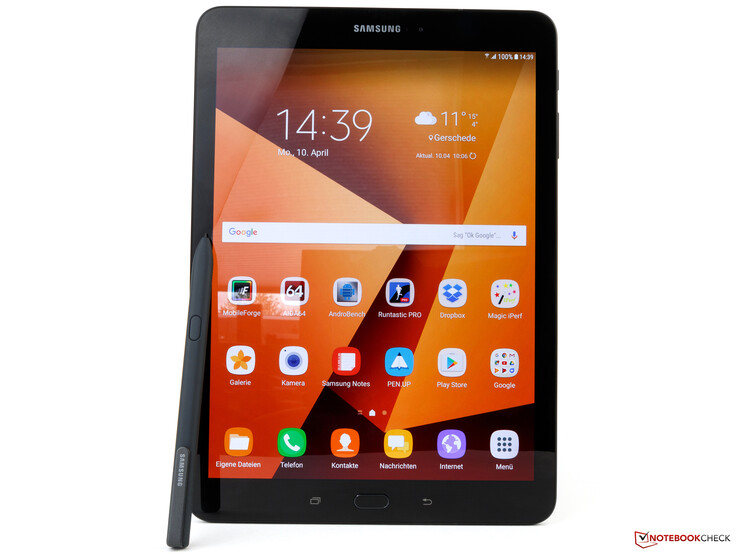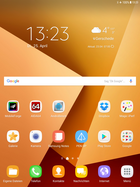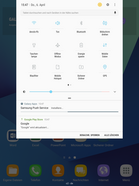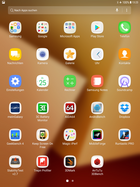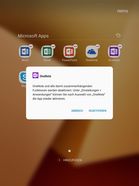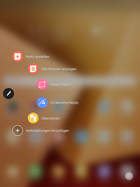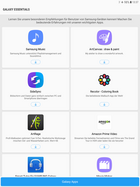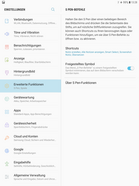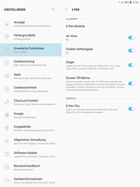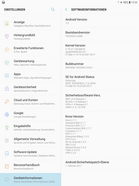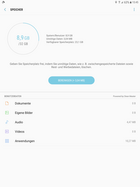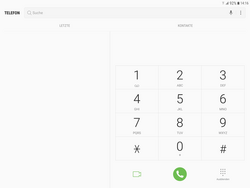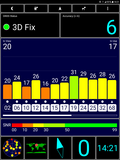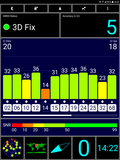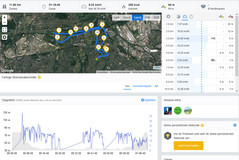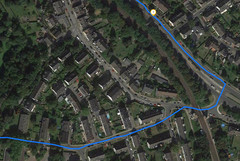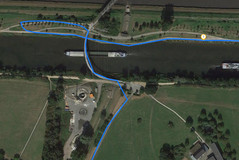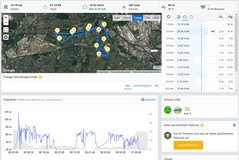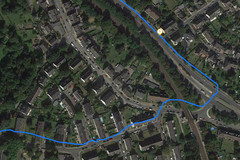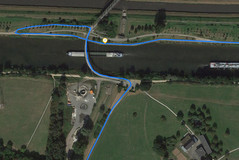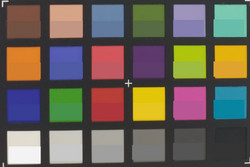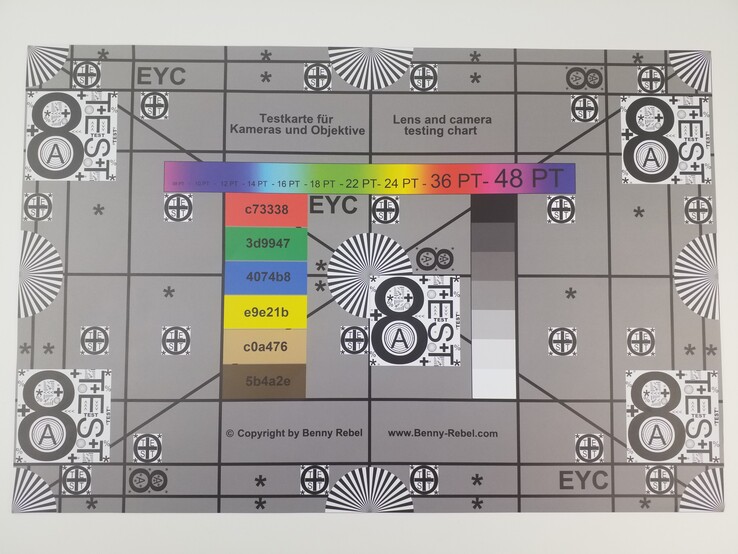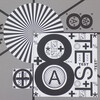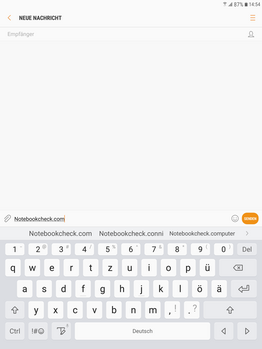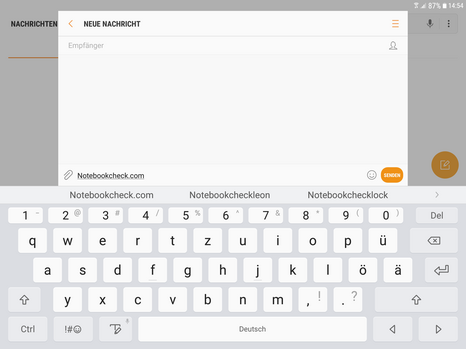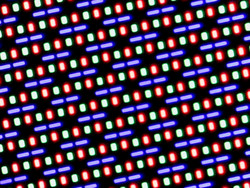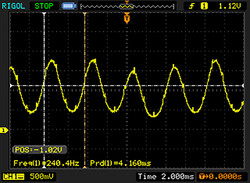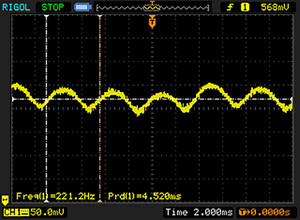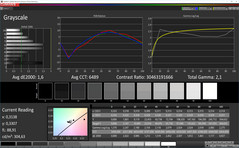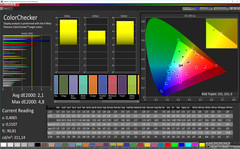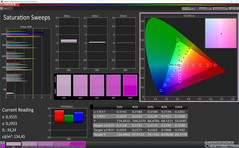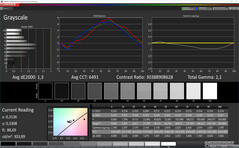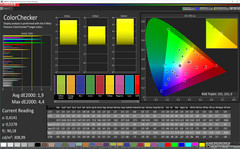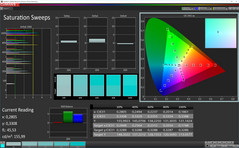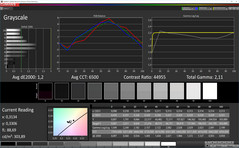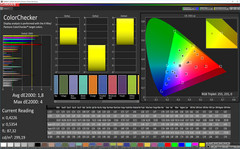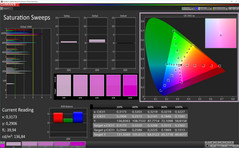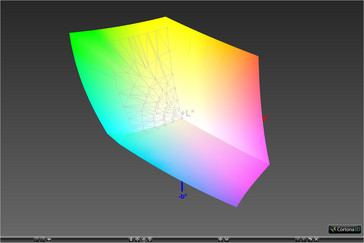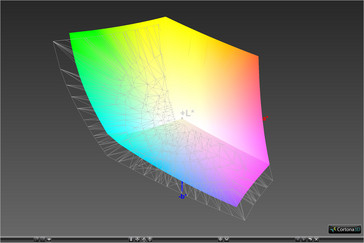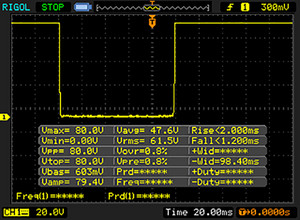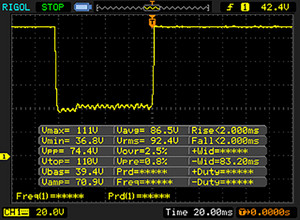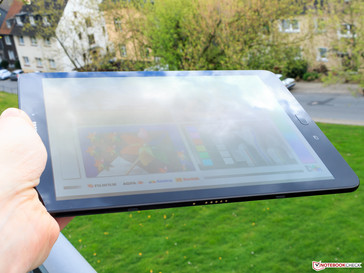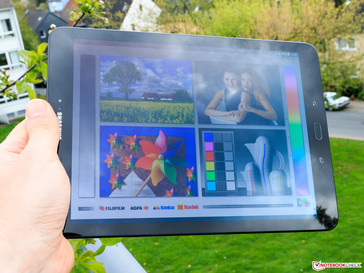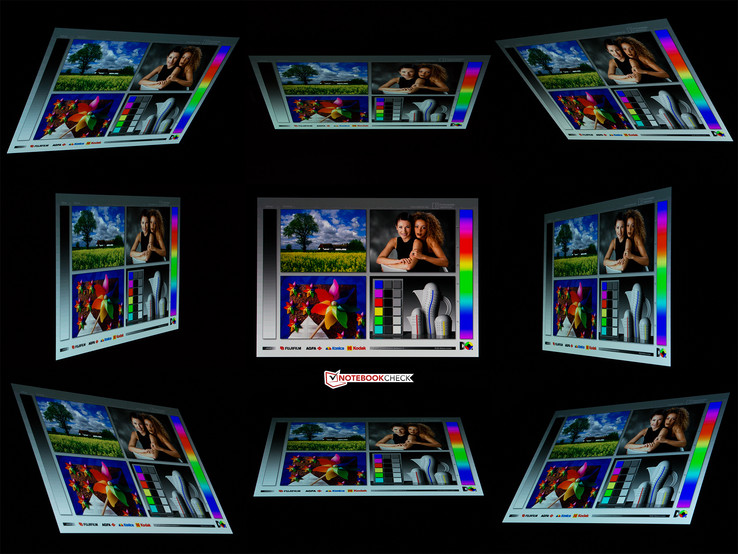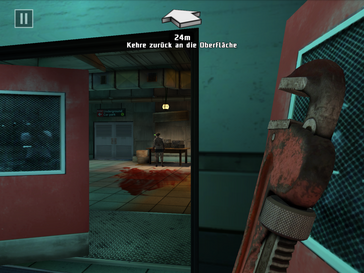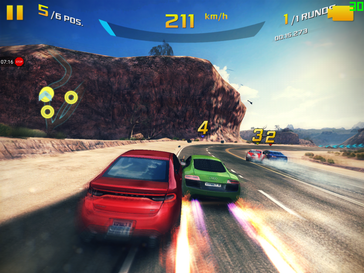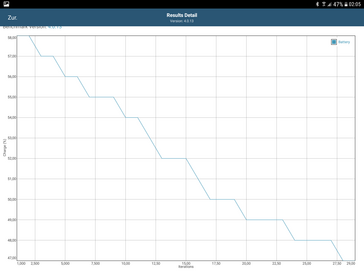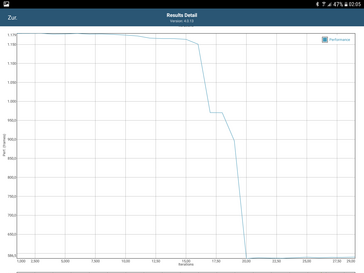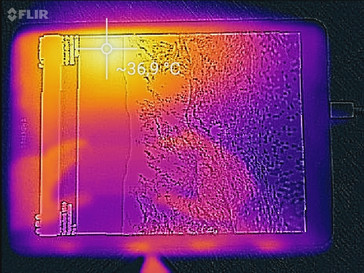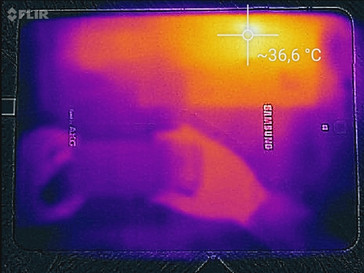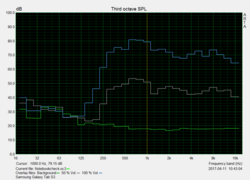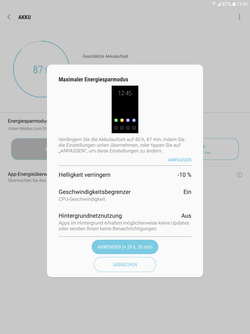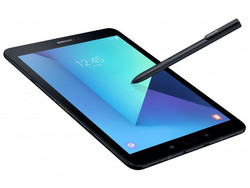Samsung Galaxy Tab S3 Tablet Review
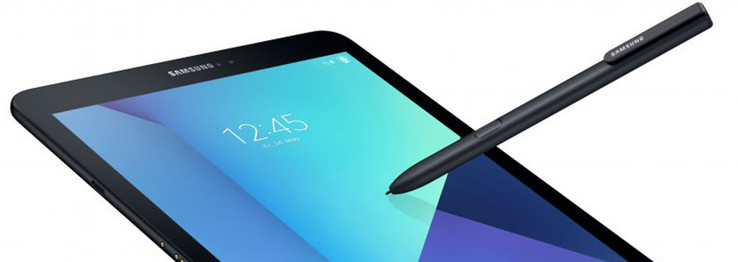
High-end Android tablets are quite rare nowadays, so the previous Samsung Galaxy Tab S2 9.7 is still a comparatively popular device. Samsung has now announced the new Galaxy Tab S3 (SM-T825) and satisfies the demand for a powerful high-end product, but has also reduced the number of products. There will not be an 8-inch model anymore and we do not expect an update for the Galaxy Note Pro models either, since the Galaxy Tab S3 is already shipped with S Pen functionality and the corresponding stylus.
Nevertheless, the new tablet offers quite a lot. It is powered by the Snapdragon 820, which is supported by 4 GB of RAM. You also get 32 GB of eMMC storage, which can be expanded by up to 256 GB via the microSD-slot. The 9.7-inch Super AMOLED screen features a high resolution and even supports HDR. A modern USB Type-C port also replaces the outdated Micro-USB. As well as a Wi-Fi only model (SM-T820); you can also get a version with LTE (SM-T825), which corresponds with our test model.
There are hardly any other expensive Android tablets anymore. Most devices are designed as convertibles by now, are often shipped with keyboards, and use Windows 10 similar to the siblings Galaxy Book 10 and Book 12. The Apple iPad Pro 9.7 is certainly the main rival for the Tab S3, but the Lenovo Yoga Book also deserves a look; you can get it both with Android and Windows. We also use the Asus ZenPad 3s 10, the Google Pixel C and the Huawei MediaPad T2 10.0 Pro as comparable devices.
Case
The Samsung Galaxy Tab S3 LTE is very slim at just 6 mm (~0.24 in), but slightly thicker than its predecessor Galaxy Tab S2 9.7 (5.6 mm/~0.22 in). Front and back are protected by Corning Gorilla Glass 4, which is fitted into an aluminum frame. The glass elements are very susceptible to fingerprints, but look very nice when they are clean. The bezels could have been a bit smaller.
The build quality of the tablet leaves an excellent impression in general. The gaps are even and the materials are sophisticated. We had some reservations in terms of stability, but there are no problems, even though there is some creaking when we try to twist it. One small issue: The frame of the card slot is only made of plastic, and there is only a combined slot for microSD- as well as Nano SIM-cards, so they can only be removed together. This was not the case for the Tab S2.
The battery is still integrated and cannot be changed by the user. Unfortunately, Samsung unfortunately has waived any protection against moisture and dust for the Galaxy Tab S3. The camera is now almost flush with the case and only a small plastic frame protects the lens against scratches. The tablet is available in black and silver.
Connectivity
You can expand the storage of the Samsung Galaxy Tab S3 via a microSD-card. All SDHC and SDXC cards are supported, and the maximum capacity you can get right now is 256 GB. As with its other products, Samsung follows its own philosophy and does not allow the formatting as internal storage or the transfer of apps to the microSD.
The manufacturer now uses the universal Type-C connector for the USB port, which supports the standards 3.1 (Gen. 1). OTG is supported as well, so you can attach external flash drives and peripherals. It is also possible to charge other devices via Tab S3.
Supported wireless standards include Bluetooth 4.2, Wi-Fi Direct as well as ANT+. It is also possible to stream media contents to suitable receivers within your local network.
Software
Samsung ships the Galaxy Tab S3 LTE with Google’s Android 7.0 Nougat in combination with its own Grace UX, which is already familiar from the Galaxy Note 7. The system is equipped with Android security patches as of February 1st 2017.
Besides feature apps from the Galaxy app store, there are also preinstalled Office apps from Microsoft. The latter cannot be deleted, but only deactivated. You can easily import notes from other Note models via backup function if you have a Samsung account. This worked perfectly with notes from a Galaxy Note Pro 12.2.
Communication and GPS
The Wi-Fi module of the Samsung Galaxy Tab S3 supports all common IEEE 802.11 standards a/b/g/n/ac in 2.4 as well as 5 GHz networks. You also get the 2x2 MIMO antenna technology, which not only does promise a better signal quality, but also higher transfer rates. The test model manages very good results in our measurements with our reference router Linksys EA8500. The range is also good and the Wi-Fi signal quality is still sufficient to stream HD videos, even in 2.4 GHz networks (at a distance of around 12 meters/~6.5 ft to the router, one wall in-between).
The LTE model is equipped with the X12 modem from Qualcomm, but it is limited to LTE Cat. 6 by Samsung. All required bands and a few more are supported, so even frequent travelers should not have any problems.
The two microphones of the Samsung Galaxy Tab S3 work well, but the recorded voice quality is pretty dull and ambient noise is not suppressed. Occasional calls are okay, but you should use a headset if using the function frequently.
| Networking | |
| iperf3 transmit AX12 | |
| Samsung Galaxy Tab S3 SM-T825 | |
| Apple iPad (2017) | |
| Asus ZenPad 3s 10 Z500M | |
| Huawei MediaPad M3 8.4 inch | |
| iperf3 receive AX12 | |
| Samsung Galaxy Tab S3 SM-T825 | |
| Apple iPad (2017) | |
| Asus ZenPad 3s 10 Z500M | |
| Huawei MediaPad M3 8.4 inch | |
The Samsung Galaxy Tab S3 LTE supports the satellite navigation systems GPS, GLONASS, BeiDou, and Galileo to locate the position. It takes a while indoors to get a clear signal. It is a bit quicker outdoors, but the accuracy could be rather better.
We took the Tab S3 on a short bicycle ride to check the everyday performance and compared the results with the bicycle navigation system Garmin Edge 500. The tablet performs well, but is not quite as accurate as the Edge 500. We can see occasional shortcuts, but the performance is perfectly adequate for car navigation.
Cameras
The front camera (f/2.2) of the Samsung Galaxy Tab S3 has a fixed focus and takes pictures at up to 5 MP. The performance is sufficient for video calls or selfies in good lighting conditions, but sharpness and details are just average. There is also a Beauty Mode for selfies and the maximum video resolution is Full HD (1920x1080 pixels, 30 fps).
The main camera of the Samsung Galaxy Tab S3 has a 13 MP sensor (4:3) with auto focus and an aperture of f/1.9. The latter is supposed to ensure good pictures in low-light situations. An image stabilizer is not available. A quick look at the specifications shows that Samsung (unlike Apple) has not equipped its premium tablet with a great camera, but only an average model. The results are decent in good lighting conditions, but they lack dynamic range, which is not changed by the automatic HDR mode either. The autofocus also has problems focusing from time to time. Pictures are rather dark in low-light situations and details are blurry, but the picture noise is not too bad.
The maximum video resolution is Ultra HD (3840x2160 pixels, 30 fps) and the clips are limited to ten minutes. The sound of the recordings is okay, but the auto focus still reveals some weaknesses especially with fast camera pans. Colors also appear very pale.
Once again, we checked the color accuracy under controlled lighting conditions and compare the results with the X-Rite ColorChecker Passport. Colors are relatively natural, but the red shades are a bit too pale and the grayscale too dark.
The picture of our test chart also reveals some weaknesses. The sharpness could be better, even in the center of the picture, but at least it stays on the same average level towards the edges. Many small details are lost and just look like a gray surface. Dark fonts on dark backgrounds also look very pale and thin.
Accessories and Warranty
The box of the Samsung Galaxy Tab S3 LTE includes a modular quick-charger (9.0 V, 1.67 A; 5.0 V, 2.0 A), a USB cable (Type-A to Type-C), a SIM-tool, the S Pen as well as a corresponding tool with three replacement tips to change them. There are also several leaflets for the warranty, security information, and a quick-start guide.
Samsung also offers optional accessories such as a keyboard cover (130 Euros/~$142) as well as the S Pen (90 Euros/~$98). Unfortunately, there is no Book Cover yet, which was common for the previous model. The S Pen from Staedtler with a pencil design, which was announced at MWC in Barcelona, will not be available in all regions. Samsung also offers generic accessories for its products.
The warranty period for the Galaxy Tab S3 is 24 months, twelve months for the battery and six months for the remaining accessories. Samsung also offers Mobile Care Packages, which covers battery or display and liquid defects for two years. Customers have to pay an additional 10% of the retail price in case of a damage.
Please see our Guarantees, Return Policies and Warranties FAQ for country-specific information.
Input Devices & Handling
TThe capacitive touchscreen of the Samsung Galaxy Tab S3 is protected by Corning Gorilla Glass 4. It provides very good gliding capabilities and is both responsive as well as precise. The display supports inputs via Samsung's S Pen, which was developed in cooperation with Wacom. It is also compatible with other Samsung devices. It works perfectly on a Galaxy Note Pro 12.2 and has even improved compared to the old S Pen, but the S Pen of the Tab S3 is even noticeably better compared with the test model, because Samsung has implemented a better digitizer layer into the panel.
Compared to the Note Pro 12.2, the new pen is bigger and therefore more comfortable to use. However, it cannot be stored inside the case anymore. At least, the optional keyboard cover offers a latch for the pen. The writing experience is totally different compared to older Pro-devices and much improved. As with the Galaxy Note 7, notes can now be taken directly on the standby screen without activating the device. The other S Pen features are similar as well. The S Pen is still not equipped with its own battery.
The physical buttons have crisp and well-defined pressure points, are very responsive and firmly integrated into the aluminum frame of the chassis. The fingerprint scanner also works conveniently and unlocks the device pretty quickly.
The optional keyboard cover is unfortunately limited to 2 different stand angles and is secured by magnets. It is not perfect for the use on the lap. The keyboard layout, however, is very good and all the 64 keys have convenient travel with a good typing experience, even though the surface is a bit squeezed due to the form factor. We also miss a background illumination for the keys. The cover is attached to the Galaxy Tab S3 via magnets and connected via POGO pins.
Display
The 9.7-inch Super AMOLED screen features 2048x1536 pixels and also supports the playback of HDR content. This is particularly good news for users of streaming services like Netflix and Amazon Video.
Our test model manages only an average brightness distribution, but this is no problem in practice. The display of the Samsung Galaxy Tab S3 reaches up to 452 nits at the center on a pure white background with the activated ambient light sensor. We can even measure up to 633 nits in the more realistic APL50 measurement, but only up to 302 nits with the manual control.
Clouding is not an issue for the Galaxy Tab S3 thanks to the OLED technology. The tablet can also produce absolute black, which ensures brilliant contrast levels that tend toward infinite. However, the tablet uses pulse-width modulation to control the luminance. It is active on every brightness level and fluctuates between 220 and 240 Hz. It seems Samsung has not used its rates AMOLED generation, but an older version, maybe even the panel from the predecessor.
| |||||||||||||||||||||||||
Brightness Distribution: 82 %
Center on Battery: 452 cd/m²
Contrast: ∞:1 (Black: 0 cd/m²)
ΔE Color 1.8 | 0.5-29.43 Ø5
ΔE Greyscale 1.2 | 0.57-98 Ø5.3
99.06% sRGB (Argyll 1.6.3 3D)
82.32% AdobeRGB 1998 (Argyll 1.6.3 3D)
94% AdobeRGB 1998 (Argyll 2.2.0 3D)
99.1% sRGB (Argyll 2.2.0 3D)
83.9% Display P3 (Argyll 2.2.0 3D)
Gamma: 2.11
| Samsung Galaxy Tab S3 SM-T825 Super AMOLED, 2048x1526, 9.70 | Samsung Galaxy Tab S2 9.7 LTE Super AMOLED, 2048x1536, 9.70 | Huawei MediaPad T2 10.0 Pro IPS, 1920x1200, 10.10 | Apple iPad Pro 9.7 IPS, 2048x1536, 9.70 | Google Pixel C LTPS, 2560x1800, 10.20 | Asus ZenPad 3s 10 Z500M IPS, 2048x1536, 9.70 | Apple iPad (2017) IPS, 2048x1536, 9.70 | |
|---|---|---|---|---|---|---|---|
| Screen | -11% | -94% | 11% | -145% | -141% | -0% | |
| Brightness middle | 452 | 358 -21% | 392 -13% | 523 16% | 487 8% | 489 8% | 514 14% |
| Brightness | 468 | 357 -24% | 385 -18% | 500 7% | 510 9% | 443 -5% | 485 4% |
| Brightness Distribution | 82 | 86 5% | 91 11% | 93 13% | 91 11% | 86 5% | 88 7% |
| Black Level * | 0.59 | 0.52 | 0.39 | 0.43 | 0.46 | ||
| Colorchecker dE 2000 * | 1.8 | 1.78 1% | 4.5 -150% | 1.1 39% | 5.24 -191% | 5.5 -206% | 1.4 22% |
| Colorchecker dE 2000 max. * | 4 | 7.8 -95% | 1.9 52% | 11.6 -190% | 2.9 27% | ||
| Greyscale dE 2000 * | 1.2 | 1.38 -15% | 4.8 -300% | 1.4 -17% | 7.95 -563% | 6.7 -458% | 2.1 -75% |
| Gamma | 2.11 104% | 2.24 98% | 2.47 89% | 2.11 104% | 2.16 102% | 2.06 107% | 2.22 99% |
| CCT | 6500 100% | 6366 102% | 7426 88% | 6662 98% | 6565 99% | 7457 87% | 6647 98% |
| Color Space (Percent of AdobeRGB 1998) | 82.32 | 62.97 -24% | |||||
| Color Space (Percent of sRGB) | 99.06 | 99.55 0% | |||||
| Contrast | 664 | 1006 | 1249 | 1137 | 1117 |
* ... smaller is better
Screen Flickering / PWM (Pulse-Width Modulation)
| Screen flickering / PWM detected | 221.2 Hz | ≤ 100 % brightness setting | |
The display backlight flickers at 221.2 Hz (worst case, e.g., utilizing PWM) Flickering detected at a brightness setting of 100 % and below. There should be no flickering or PWM above this brightness setting. The frequency of 221.2 Hz is relatively low, so sensitive users will likely notice flickering and experience eyestrain at the stated brightness setting and below. In comparison: 53 % of all tested devices do not use PWM to dim the display. If PWM was detected, an average of 17924 (minimum: 5 - maximum: 3846000) Hz was measured. | |||
We check the color accuracy of the Samsung Galaxy Tab S3 with a spectrophotometer and the analysis software CalMAN. As with its predecessor, there are different picture modes. The adaptive settings are active by default, which is supposed to select the right settings based on the content. There are also three selectable color profiles, and we had a closer look at them.
All profiles manage very accurate color and visible deviations for the human eye are limited to individual colors. We can see the highest deviation for blue with the profile Simple at a DeltaE value of 4.8. The grayscale never exceeds a DeltaE of 2.6 in any case. We noticed the biggest differences in terms of color gamut. While the profile Simple is using the smaller sRGB, Photo is targeting AdobeRGB and Cinema P3. The color gamut is also comparatively wide.
Display Response Times
| ↔ Response Time Black to White | ||
|---|---|---|
| 3.2 ms ... rise ↗ and fall ↘ combined | ↗ 2 ms rise | |
| ↘ 1.2 ms fall | ||
| The screen shows very fast response rates in our tests and should be very well suited for fast-paced gaming. In comparison, all tested devices range from 0.1 (minimum) to 240 (maximum) ms. » 9 % of all devices are better. This means that the measured response time is better than the average of all tested devices (21.5 ms). | ||
| ↔ Response Time 50% Grey to 80% Grey | ||
| 4 ms ... rise ↗ and fall ↘ combined | ↗ 2 ms rise | |
| ↘ 2 ms fall | ||
| The screen shows very fast response rates in our tests and should be very well suited for fast-paced gaming. In comparison, all tested devices range from 0.2 (minimum) to 636 (maximum) ms. » 10 % of all devices are better. This means that the measured response time is better than the average of all tested devices (33.7 ms). | ||
Performance
The Qualcomm Snapdragon 820 inside the Samsung Galaxy Tab S3 is not the latest high-end SoC anymore, but the performance is still very good. The graphics adapter Adreno 530 shares the designation with the GPU from the 821, but the clocks are slightly lower. The components are rounded off by 4 GB of RAM.
The tablet performs well in the benchmarks, only PCMark determines a score on par with the predecessor Galaxy Tab S2, and even the Galaxy S8+ is only a tad faster. The comparison with the modern high-end smartphone from Samsung still shows that the CPU and GPU performance could have been better with a current top-tier SoC. The iPad (2017) is also faster than the test model in the system as well as GPU benchmarks. This does not make a big difference in practice right now, but might change in 1 or 2 years.
| GFXBench | |
| on screen Car Chase Onscreen | |
| Samsung Galaxy Tab S3 SM-T825 | |
| Samsung Galaxy S8 Plus | |
| Google Pixel C | |
| Huawei MediaPad M3 8.4 inch | |
| Asus ZenPad 3s 10 Z500M | |
| 1920x1080 Car Chase Offscreen | |
| Samsung Galaxy S8 Plus | |
| Google Pixel C | |
| Samsung Galaxy Tab S3 SM-T825 | |
| Huawei MediaPad M3 8.4 inch | |
| Asus ZenPad 3s 10 Z500M | |
| PCMark for Android | |
| Work performance score | |
| Google Pixel C | |
| Samsung Galaxy S8 Plus | |
| Samsung Galaxy Tab S3 SM-T825 | |
| Samsung Galaxy Tab S2 9.7 LTE | |
| Huawei MediaPad M3 8.4 inch | |
| Lenovo Yoga Book Android YB1-X90F | |
| Asus ZenPad 3s 10 Z500M | |
| Huawei MediaPad T2 10.0 Pro | |
| Work 2.0 performance score | |
| Samsung Galaxy Tab S3 SM-T825 | |
| Samsung Galaxy S8 Plus | |
| Storage score | |
| Samsung Galaxy S8 Plus | |
| Samsung Galaxy Tab S3 SM-T825 | |
| Geekbench 4.4 | |
| 64 Bit Single-Core Score | |
| Samsung Galaxy S8 Plus | |
| Samsung Galaxy Tab S3 SM-T825 | |
| 64 Bit Multi-Core Score | |
| Samsung Galaxy S8 Plus | |
| Samsung Galaxy Tab S3 SM-T825 | |
| Basemark ES 3.1 / Metal - offscreen Overall Score | |
| Samsung Galaxy S8 Plus | |
| Apple iPad Pro 9.7 | |
| Apple iPad (2017) | |
| Google Pixel C | |
| Samsung Galaxy Tab S3 SM-T825 | |
| ANDEBench PRO | |
| Device Score | |
| Google Pixel C | |
| Samsung Galaxy Tab S3 SM-T825 | |
| CoreMark-PRO/HPC (Base) | |
| Samsung Galaxy Tab S3 SM-T825 | |
| Google Pixel C | |
| Memory Bandwidth | |
| Samsung Galaxy Tab S3 SM-T825 | |
| Google Pixel C | |
| Memory Latency | |
| Google Pixel C | |
| Samsung Galaxy Tab S3 SM-T825 | |
| Storage | |
| Google Pixel C | |
| Samsung Galaxy Tab S3 SM-T825 | |
| Platform | |
| Google Pixel C | |
| Samsung Galaxy Tab S3 SM-T825 | |
| 3D | |
| Google Pixel C | |
| Samsung Galaxy Tab S3 SM-T825 | |
| Epic Citadel - Ultra High Quality | |
| Samsung Galaxy S8 Plus | |
| Google Pixel C | |
| Samsung Galaxy Tab S3 SM-T825 | |
We use the preloaded Samsung Browser 5.2 for the browser benchmarks. The results are good, but cannot compete with Apple’s iPads and also reveal some weaknesses in terms of the Java applications you can use within the browser. Subjectively, however, we could not determine any limitations in everyday applications and websites are completely and quickly loaded on the Samsung Galaxy Tab S3.
* ... smaller is better
The Samsung Galaxy Tab S3 is equipped with 32 GB of eMMC storage, but you can only use 23.1 GB after the initial set-up. The flash storage is slightly faster compared to the Galaxy Tab S2 9.7, but far from being fast by modern standards. Samsung could at least include 64 GB if the storage is so slow.
It is also possible to expand the storage via a microSD-card. The performance of the slot is on a combatively good level, but it cannot utilize the full performance of our reference card Toshiba Exceria Pro M401 (THN-M401S0640E2, UHS-1 Class 3, up to 95 MB/s read, up to 80 MB/s write).
| Samsung Galaxy Tab S3 SM-T825 | Samsung Galaxy Tab S2 9.7 LTE | Huawei MediaPad T2 10.0 Pro | Google Pixel C | Huawei MediaPad M3 8.4 inch | Asus ZenPad 3s 10 Z500M | Lenovo Yoga Book Android YB1-X90F | Samsung Galaxy S8 Plus | |
|---|---|---|---|---|---|---|---|---|
| AndroBench 3-5 | -32% | -52% | -25% | 9% | -27% | -34% | 80% | |
| Sequential Read 256KB | 288.6 | 248.2 -14% | 131 -55% | 154.3 -47% | 249.7 -13% | 209.3 -27% | 143.4 -50% | 788 173% |
| Sequential Write 256KB | 87.6 | 49.37 -44% | 78.2 -11% | 109.4 25% | 117.2 34% | 136.5 56% | 80.6 -8% | 194.2 122% |
| Random Read 4KB | 45.82 | 25.56 -44% | 14.59 -68% | 19.96 -56% | 32.04 -30% | 24.85 -46% | 23.5 -49% | 127.2 178% |
| Random Write 4KB | 13.13 | 9.82 -25% | 9.86 -25% | 10.08 -23% | 31.35 139% | 6.8 -48% | 11.7 -11% | 15.27 16% |
| Sequential Read 256KB SDCard | 76.4 | 17.57 -77% | 61.7 -19% | 45.15 -41% | 48.9 -36% | 71.1 -7% | ||
| Sequential Write 256KB SDCard | 58.6 | 13.98 -76% | 23.52 -60% | 26.9 -54% | 30.6 -48% | 57.2 -2% |
Games
The Qualcomm Adreno 530 in the Samsung Galaxy Tab S3 is a powerful GPU, which supports modern graphics interfaces such as OpenGL ES 3.2 or Vulkan. It is powerful enough for smooth gameplay in all games from the Google Play Store, even at the highest settings.
This is supported by the benchmarks. It does not matter if you play “Asphalt 8” or “Dead Trigger 2”, both games can be enjoyed without stutters. The loading times, however, are slightly longer due to the slow storage. It also looks as if Samsung has installed a frame limit, because both games are capped at 30 fps, which is sufficient for smooth gameplay. The frame rates in “Asphalt 8” are steady, even after one hour.
Both the sensors and the touchscreen work flawlessly and the Galaxy Tab S3 is compact enough for the hands, despite its size. The sound is comparatively good, not only because of the four speakers, but you can also never completely cover them with the hand.
| Dead Trigger 2 | |||
| Settings | Value | ||
| high | 30 fps | ||
| Asphalt 8: Airborne | |||
| Settings | Value | ||
| high | 30 fps | ||
| very low | 30 fps | ||
Emissions
Temperature
The surfaces of the Samsung Galaxy Tab S3 are never lukewarm, not even under sustained workloads and most areas do not exceed 30 °C (~86 °F). The highest recorded temperature while idling is just 28.9 °C (~84 °F).
We had a closer look at the performance under sustained workloads with the GFXBench Battery Test Manhattan 3.1. The Tab S3 can maintain its performance for 16 runs of the demanding test, before the results drops by almost 50%. Our sustained gaming test with “Asphalt 8” in the Games section, however, shows that this does not affect the gaming capabilities in practice.
(+) The maximum temperature on the upper side is 34.4 °C / 94 F, compared to the average of 33.8 °C / 93 F, ranging from 20.7 to 53.2 °C for the class Tablet.
(+) The bottom heats up to a maximum of 31.1 °C / 88 F, compared to the average of 33.3 °C / 92 F
(+) In idle usage, the average temperature for the upper side is 27.8 °C / 82 F, compared to the device average of 30 °C / 86 F.
Speakers
The four stereo speakers of the Samsung Galaxy Tab S3 were developed in cooperation with AKG and Harman and work similar to the modules in the Apple iPad Pro 9.7. They automatically adjust to the orientation of the tablet and provide an even sound experience; it does not matter if you use the Tab S3 in portrait or landscape mode. This works very well in practice.
The quality of the speakers is comparatively good and the performance for mids and high tones is pretty linear; only the iPad Pro is better within the comparison. The Tab S3 can be really loud at more than 86 dB(A), but will sound a bit tinny in this case. The result is decent when you use average volume levels. We cannot hear background noise, even with a very quiet playback.
Samsung is using a Qualcomm SoC, so Bluetooth supports the playback of audio contents via aptX HD (24-bit, high-res). We did not experience any issues with the connection. The output via 3.5 mm stereo jack is also possible and the playback is subjectively clear and without any static.
Samsung Galaxy Tab S3 SM-T825 audio analysis
(+) | speakers can play relatively loud (86.5 dB)
Bass 100 - 315 Hz
(-) | nearly no bass - on average 26.5% lower than median
(±) | linearity of bass is average (14.5% delta to prev. frequency)
Mids 400 - 2000 Hz
(±) | higher mids - on average 5.1% higher than median
(+) | mids are linear (5.2% delta to prev. frequency)
Highs 2 - 16 kHz
(+) | balanced highs - only 1.9% away from median
(+) | highs are linear (5.6% delta to prev. frequency)
Overall 100 - 16.000 Hz
(±) | linearity of overall sound is average (17.9% difference to median)
Compared to same class
» 36% of all tested devices in this class were better, 8% similar, 56% worse
» The best had a delta of 7%, average was 23%, worst was 129%
Compared to all devices tested
» 31% of all tested devices were better, 8% similar, 61% worse
» The best had a delta of 4%, average was 25%, worst was 134%
Apple iPad Pro 9.7 audio analysis
(+) | speakers can play relatively loud (90.6 dB)
Bass 100 - 315 Hz
(-) | nearly no bass - on average 23.2% lower than median
(±) | linearity of bass is average (8.6% delta to prev. frequency)
Mids 400 - 2000 Hz
(+) | balanced mids - only 4.7% away from median
(+) | mids are linear (4.9% delta to prev. frequency)
Highs 2 - 16 kHz
(+) | balanced highs - only 4.6% away from median
(+) | highs are linear (4.1% delta to prev. frequency)
Overall 100 - 16.000 Hz
(±) | linearity of overall sound is average (16.8% difference to median)
Compared to same class
» 32% of all tested devices in this class were better, 4% similar, 64% worse
» The best had a delta of 7%, average was 23%, worst was 129%
Compared to all devices tested
» 24% of all tested devices were better, 7% similar, 69% worse
» The best had a delta of 4%, average was 25%, worst was 134%
Google Pixel C audio analysis
(+) | speakers can play relatively loud (92.8 dB)
Bass 100 - 315 Hz
(-) | nearly no bass - on average 29.9% lower than median
(±) | linearity of bass is average (7.5% delta to prev. frequency)
Mids 400 - 2000 Hz
(+) | balanced mids - only 4.8% away from median
(±) | linearity of mids is average (7% delta to prev. frequency)
Highs 2 - 16 kHz
(±) | higher highs - on average 7.5% higher than median
(±) | linearity of highs is average (8.6% delta to prev. frequency)
Overall 100 - 16.000 Hz
(±) | linearity of overall sound is average (24.2% difference to median)
Compared to same class
» 69% of all tested devices in this class were better, 7% similar, 24% worse
» The best had a delta of 7%, average was 23%, worst was 129%
Compared to all devices tested
» 69% of all tested devices were better, 7% similar, 25% worse
» The best had a delta of 4%, average was 25%, worst was 134%
Frequency Comparison (Checkboxes select/deselectable!)
Battery Runtime
Power Consumption
Samsung has reduced the power consumption of the Galaxy Tab S3 significantly compared to the previous model; it is only beaten by some rivals while idling at the lowest luminance. Good news for the battery runtimes.
The tablet also supports Quick Charge 3.0, but it is only shipped with the usual quick-charge adapter from Samsung, so the possibilities are not fully utilized. A full recharge takes about three hours; the charge is 13% after 15 minutes and 23% after 30 minutes. 80% is available after 103 minutes.
The provided power adapter is very efficient and only pulls 0.0005 watts from the socket.
| Off / Standby | |
| Idle | |
| Load |
|
| Samsung Galaxy Tab S3 SM-T825 6000 mAh | Samsung Galaxy Tab S2 9.7 LTE 5870 mAh | Apple iPad Pro 9.7 7306 mAh | Huawei MediaPad T2 10.0 Pro 6600 mAh | Google Pixel C mAh | Asus ZenPad 3s 10 Z500M 5900 mAh | Apple iPad (2017) 8.827 mAh | |
|---|---|---|---|---|---|---|---|
| Power Consumption | -31% | -59% | -5% | -32% | -25% | -64% | |
| Idle Minimum * | 2.08 | 2.3 -11% | 1.71 18% | 1.58 24% | 1.82 12% | 1.59 24% | 2.06 1% |
| Idle Average * | 3.5 | 4.5 -29% | 7.55 -116% | 4.12 -18% | 4.26 -22% | 4.14 -18% | 7.42 -112% |
| Idle Maximum * | 3.58 | 5 -40% | 7.62 -113% | 4.15 -16% | 4.33 -21% | 4.23 -18% | 7.47 -109% |
| Load Average * | 6.97 | 9.4 -35% | 8.39 -20% | 6.2 11% | 9.82 -41% | 10.89 -56% | 9.45 -36% |
| Load Maximum * | 7.4 | 10.4 -41% | 12.08 -63% | 9.27 -25% | 13.99 -89% | 11.58 -56% | 12.31 -66% |
* ... smaller is better
Battery Runtime
The battery of the Samsung Galaxy Tab S3 has a capacity of 6000 mAh and is only slightly bigger compared to the Tab S2 9.7 (5870 mAh). The battery runtimes, however, are significantly longer, thanks to the reduced power consumption.
The Galaxy Tab S3 performs well among the comparison group and even beats the two iPads. The tests at an adjusted luminance of 150 nits are perfect to compare the rivals. Samsung’s tablet is basically on par with the Apple competitor in the Wi-Fi test, but the video runtime is much shorter. The runtime of 6:33 hours in the PCMark for Android Work 2.0 Battery Test is also only an average result.
Samsung has implemented several power-saving features to increase the battery runtime of the Samsung Galaxy Tab S3. They have an effect on the luminance, processor performance, and the background activities of apps.
We refer to this article if you want to know the right way to charge lithium-ion batteries to maintain their capacity and extend their lifespan.
| Samsung Galaxy Tab S3 SM-T825 6000 mAh | Samsung Galaxy Tab S2 9.7 LTE 5870 mAh | Huawei MediaPad T2 10.0 Pro 6600 mAh | Asus ZenPad 3s 10 Z500M 5900 mAh | Apple iPad (2017) 8.827 mAh | Apple iPad Pro 9.7 7306 mAh | |
|---|---|---|---|---|---|---|
| Battery Runtime | -26% | -27% | -22% | -2% | -6% | |
| Reader / Idle | 1903 | 918 -52% | 1230 -35% | 1453 -24% | 1496 -21% | 1850 -3% |
| H.264 | 551 | 651 18% | 593 8% | 600 9% | 845 53% | 708 28% |
| WiFi v1.3 | 760 | 393 -48% | 416 -45% | 518 -32% | 764 1% | 779 3% |
| Load | 375 | 291 -22% | 248 -34% | 225 -40% | 225 -40% | 186 -50% |
Pros
Cons
Verdict
Samsung’s Galaxy Tab S3 LTE is a very good tablet, which does not rely on modern high-end hardware across the board (as with the Apple iPad 2017), but the overall package is very compelling.
The Samsung Galaxy Tab S3 might not offer many superlatives, but it is currently the best Android tablet.
Besides a great display with HDR support, good speakers, improved battery runtimes and S Pen support, the Wi-Fi module in particular is very fast. The integrated Snapdragon 820 is certainly not the latest SoC from Qualcomm, but the performance is still very good. Only the small and slow eMMC storage is not a good fit for a premium multimedia tablet. Samsung has not included very good cameras either, so there is no real premium feeling.
We really like the S Pen support though. It is shipped with every Tab S3 and leaves an excellent impression. 770 Euros (~$839) is still a lot of money for a tablet, and there are not many reasons to switch if you already own a Galaxy Tab S2 9.7 and can do without the pen.
Samsung Galaxy Tab S3 SM-T825
-
04/26/2017 v6(old)
Daniel Schmidt


 Deutsch
Deutsch English
English Español
Español Français
Français Italiano
Italiano Nederlands
Nederlands Polski
Polski Português
Português Русский
Русский Türkçe
Türkçe Svenska
Svenska Chinese
Chinese Magyar
Magyar